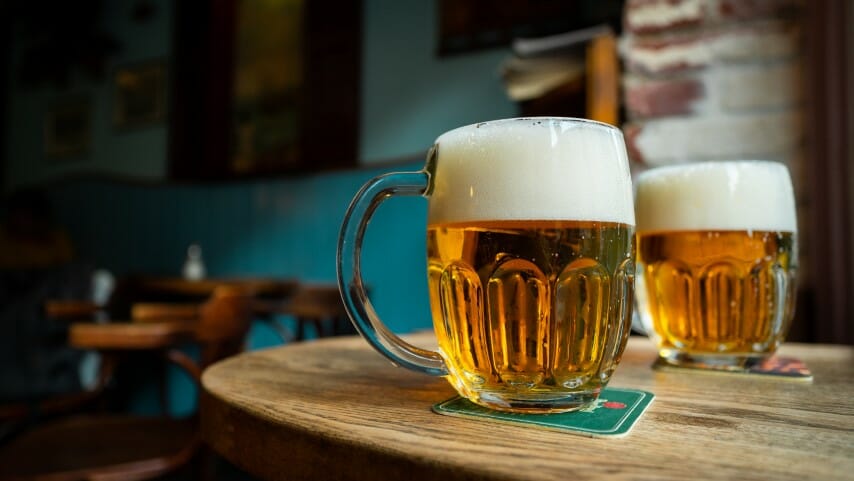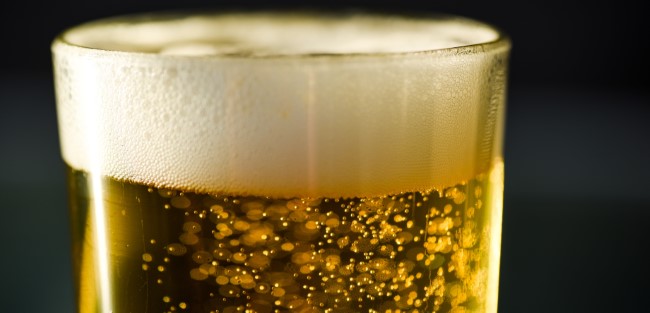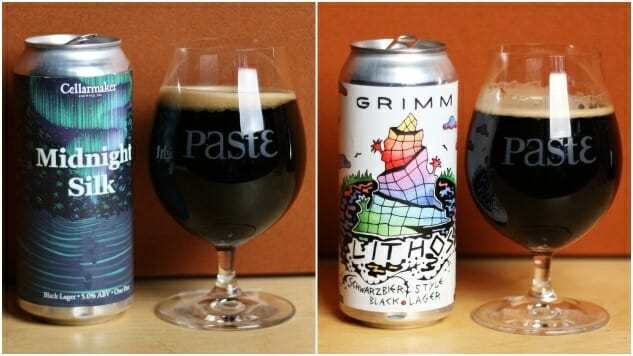The Craft Lager Boom Is the Best Thing About the Modern Beer World

When it comes to observation and critique of the craft beer landscape as it exists today, it’s often difficult for me to not feel like some combination of cynic, crank or senior citizen, despite the fact that I’m 35 years old. I imagine, though, that this isn’t an uncommon feeling for those who have observed the world of craft beer for a decade or more—we’ve watched the prevailing styles and trends change and morph around us in that time, from the IBU-touting India pale ales of the mid-2000s to the advent of new hop varietals that eventually led the idea of “hoppy beer” in a very different and novel direction. Many styles bear little resemblance today to how they may have presented in the American craft beer scene 15 years ago, and this is by no means some kind of universally bad thing, or an existential threat to craft beer itself.
Change is, after all, inevitable, and that transformation is what forged the concept of “American” beer styles in the first place as they evolved away from their British or German progenitors. Still, the end result of some of these most prominent changes—particularly the omnipresent dominance of hazy IPA over tap handles, and the ubiquity of ultra-sweet styles such as smoothie sours and pastry stouts—can occasionally result in a beer fan like myself feeling as if the beer scene has effectively passed them by. When the vast majority of beer on tap at the average taproom is in a limited handful of styles that rarely appeal to you, are you still the target demographic for a craft brewery?
There is, however, a saving grace to the beer world as it exists today, and it’s the lifegiving vitality and variety of craft lager available in taprooms, if not always on store shelves. A trend of recent years that has grown into what feels like a more permanent niche of brewery culture, even as the quality of the beer itself has only increased, the availability of craft lager represents a desperately needed (and much appreciated) alternative to the other styles that command peak popularity at most taprooms. In a diverse array of styles, these lagers are able to offer several key experiences that keep me coming back to my local breweries, and I’m thankful for the respite they provide.
Or in other words: I know there are a ton of drinkers out there who can still summon enthusiasm for _____ Hyped Brewery’s three new hazy IPA cans, released every Friday afternoon. If that’s your thing, feel free to enjoy—I’m just thankful that the same brewery is now likely to have a few excellent lagers as well. But how did we get here?
The Slow Ascent of Craft Lager

It really wasn’t all that long ago, comparatively speaking, when the presence of any lager on a small craft brewery’s taplist was more an exception than a rule. Go back far enough, and there are likely cultural reasons for this, ingrained among an earlier generation of craft beer drinkers. The American craft beer industry for decades defined itself in opposition to “Big Beer” and their bland, tasteless lagers, conditioning drinkers to ditch many lager styles for bolder, more aggressive flavors. At the same time, there were practical considerations as well—lagers are more laborious to produce than warm-fermented ales, and they require longer for the titular lagering period at low temperatures, which ties up a brewery’s tanks. Because of this, if you were hanging around with craft brewers in the 2000s, you’d frequently hear them saying things like “lagers aren’t cost feasible,” or implying that American drinkers didn’t want them. You don’t hear those brewers making either statement today.
There were always some craft lager beer styles around, of course, but they made up a faint undertow to the beer scene, and never possessed what one might call true cache in the beer geek scene. In particular, the major craft “pilsner” brands of this era were often fairly uninspired beers by modern standards, with a blandness that has today been replaced by more dynamic flavors. Drinkers of this era more frequently had to turn to imported lagers for an exciting rendition of many classic styles.
Gradually, things began to change in the 2010s, and by the middle of the decade, trend pieces were being written about craft lager as “the next big thing.” In retrospect, some of these pieces feel like they may have been premature—as growth in the craft segment finally began to slow in the back half of the decade, it seemed as if more of the larger regional craft brewers were looking at a somewhat generic idea of “lager” and seeing potential dollar signs in their hopes of establishing a major brand in an underexploited craft beer niche. Not all of these generic Brewery Name Lagers stuck around, but they served an important role in acclimating the rank-and-file craft drinker to the idea of:
1. Regularly drinking lager styles produced by your local craft brewery, and
2. Paying similar prices for craft lager that one would expect to pay for other beer styles from a craft brewery. The latter is a perceptual hurdle that the style needed to overcome, if it was ever going to get around the question of “If Bud is cheap, why isn’t your lager cheap as well?”
This steady move in the direction of lager resulted in an evolving craft beer scene where, by the time we reached the back part of the 2010s, it became common enough to now expect to find a decently executed pilsner at most of the brewery taprooms you might visit. In the last few years, however, the beer geek passion for lager has truly bloomed into something more vocal and eclectic, which has resulted in a notable increase in lager diversity and appreciation. Whereas in 2019, one might have walked into that brewery expecting to find a pilsner, now you might well find a variety of pilsner substyles, not to mention many other lagers of all descriptions. This week, I set foot in a brewery pouring German pilsner, Czech pilsner, Italian pilsner and American pilsner at the same time—along with many other lagers, and plentiful other beer styles—and it felt like the first time in quite a while that I was seeing a true variety of flavors on display. And that was a great feeling.
That’s the biggest thing that has changed, in the last few years—i.e., the pandemic era—ease of access to good craft lagers has increased exponentially, and breweries have seemingly gotten much better at making them! Even breweries not particularly known for lager are now frequently producing excellent examples, and I’ve seen a notable number of breweries also rebrand themselves to revolve more tightly around lager as a central philosophy. Case in point: In Richmond, Virginia, where I reside, a brewery that initially opened several years ago with a focus on wild ales and kettle sours has almost completely rebranded in the last year to make lager their central focus.
The Joy of Modern Craft Lagers (And Dark Lagers!)

If you’ve never been much a fan of lager, please do not make the mistake of believing that all, or even most, lager beer styles are particularly similar to one another. Saying “lager” is exactly like saying “ale,” in the sense that you’re invoking a sprawling family tree of beer styles, and there’s never been as much diversity in craft lager in the U.S. as there is right now. And importantly, those lagers are often filling niches or providing experiences that are increasingly hard to find among American ale styles.
Most obviously, lager styles such as pilsner allow us to enjoy the aromatics and flavors of noble hops, absent for long periods in terms of their prominence in American craft beer. In fact, the gradient of hop-forward German lager styles—helles, Dortmunder lager, pilsner, etc—allows one to specifically pick out how much balancing malt character you enjoy, or how much hop bitterness you prefer. Pilsner substyles offer subtle variations, from the floral flintiness of German pils, to the spicier buzz of Czech pils synonymous with Saaz hops, to the evolving vivaciousness of dry-hopped Italian pils. They’re a way to enjoy hops that exists on a completely different conceptual plane from American IPA, which is increasingly defined not just by fruitiness but by big residual sweetness, without the bitterness to balance. And where complete pursuit of one ideal such as “juiciness” is common in American IPA, a modicum of balance tends to be valued in styles such as pilsner. Subtlety still lives here, and these styles may even be teaching new drinkers an appreciation for less bombastic flavors.
At the same time, though, pilsner can also be an experimental playground all its own, offering an opportunity for brewers to dabble with newly developed and unconventional hop varietals … while still doing so in a more delicate and subtle way than the consumer expects in IPA. Personally, it’s a little hard for me to think of the resulting beers as “pilsner,” when they’re made with a newly named South African or New Zealand hop varietal, but the styles do serve a purpose, giving drinkers a fresh way to taste new hop flavors without having to completely go overboard in the context of a triple dry-hopped hazy IPA.
That’s the thing I love most about the craft lager boom: It lets me have experiences that had become difficult to find in the rest of the beer world. For instance, some of my favorite beer styles are traditional, non-adjunct dark beers such as American robust porter and the almost vanished American-style stout. Today, those styles can be harder and harder to find in their non-adjunct state, with fewer breweries producing standard-strength porter and stout to begin with, instead of heavily sweetened and adjuncted imperial pastry stouts. Ask the brewers, and they’ll tell you that consumers simply don’t want non-adjunct porter or stout.
Enter, dark lager styles, which have swept into popularity in many smaller taprooms while seemingly riding the coattails of pilsner. These styles, such as dunkel, schwarzbier, and Czech dark lager, are a lifeline to drinkers like myself who like dry, roasty flavors in their beer, which had become increasingly hard to find. It’s not a one-to-one replacement, sure, but you can be sure that my eyes light up whenever I’m craving a dark beer style and I run across a sessionable, roasty, dry schwarzbier in a taproom. In 2022, there’s no style I’m more likely to automatically order than craft dark lager—they are scratching an itch that the ale market has had little interest in pursuing lately. And judging from the way these dark lager styles are seemingly cropping up in small breweries in nearly every city I visit, there’s a vocal undercurrent of beer fans and brewers who feel quite similarly.
Ultimately, it’s hard to say where this modern craft lager surge is headed in the next few years, but from my vantage point it shows little sign of slowing down. I don’t expect craft lager to ever supplant the likes of IPA, but I’m not really advocating for that to happen either. Hops will likely always drive the American craft beer scene, but lager allows for those hops to do so in new and refreshing ways. I’m simply happy that these beers exist, and have become so much easier to find, while also becoming more deliciously engaging at the same time.
For a frequent craft beer cynic, being this unabashedly happy about a modern development isn’t exactly common. I’m thankful that lager manages to bring out that optimist in me, one dimpled mug at a time.
Jim Vorel is a Paste staff writer and resident beer and liquor geek. You can follow him on Twitter for more drink writing.